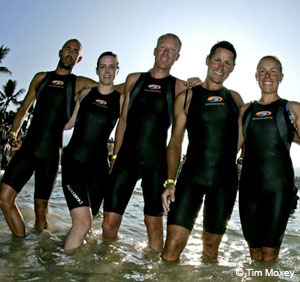Ironman is wetsuit legal
After a flurry of hand-ringing posts on the Slowtwitch reader forum in response to new rules posted on the Oceanside 70.3 website, Ironman has dropped its prohibition of wetsuits and swimskins that appeared overnight on the Ironman California portal.
Wetsuits that exceed 5mm in thickness will be legal at Ironman events that are wetsuit-legal, as will so-called fastskins or swimskins at all Ironman events.
Ironman's Steve Meckfessel stressed that there is no ban in place on either style of garment, and, no date when any such ban is currently contemplated. Any rule changes will depend on the discussions on rule dispensations between Ironman and USA Triathlon.
At the start of the day today, the Ironman California website had updated its rules to contain these two new swim-specific directives:
Swim Course Rules and Instructions
7. Wetsuits must be 5mm thick or less.
8. Swimwear must be 100% textile material, which is defined as materials consisting of natural and/or synthetic, individual and non-consolidated yarns used to constitute a fabric by weaving, knitting, and/or braiding. Simply put, this would generally refer to suits made only from nylon or Lycra that do not have any rubberized material such as polyurethane or neoprene. Swimwear may not cover the neck, extend past the shoulder, nor extend past the knees. Swimwear may contain a zipper. A race kit may be worn underneath swimwear.
Concerns were several. Most obvious were dozens or hundreds of competitors registered at wetsuit-legal Ironman events that had invested six-hundred dollars or more in De Soto's Water Rover, a wetsuit that featured panels exceeding the 5mm max rule thickness.
On the subject of swimskins, according to two manufacturers who spoke to Slowtwitch, the intent of Ironman in its rule (8) above, was to parallel FINA's rules on such racing apparel. But this new Ironman rule seemed to mirror FINA's rules on pool swimming, not the World swimming governing body's more relaxed rules on open-water swimming. Further, FINA's rules contain a sunset period, typical whenever a governing body in any sport intends to ban a previously legal class of equipment.
The other concern, voiced by two executives at USAT, is whether Ironman had followed its own stated policy—and USAT's requirement—to apply for and be granted a dispensation from USAT's rules. USA Triathlon has no rule prohibiting wetsuit thickness or against the use of swimskins in swim events, so, for Ironman to ban such apparel should require a dispensation.
Ironman has not yet submitted any of its rule dispensation requests for 2010 to USAT, but, Meckfessel maintains that most or all dispensation topics have been discussed for months, going back to the Clearwater event in November, and Ironman and USAT have a verbal understanding on many or most of the rule variances. The submission of this list of dispensations to USAT by Ironman is imminent.
Might this prohibition on these two garment classes return? Perhaps, depending on what dispensations have been requested of USAT. In any case, neither class of garment will be prohibited until, at the earliest, September 1 of 2010, the commencement of Ironman's qualifying season, according to Meckfessel.
Asked if January 1, 2011 is another, potential, and logical, date of implementation, Meckfessel agreed.
The decision to allow both wetsuits and swimskins gives Ironman an opportunity to fine tune the crafting of these new rules, assuming such dispensations are granted. Is a 5mm wetsuit one that has any panel exceeding 5mm? Or rubber coverage that, on average, does not exceed 5mm? What about 5mm seams? Or rubber that is 5mm nominally but, during the bun-slicing process at a rubber manufacturer, has panels that vary from 4.8 to 5.5mm?
The swimskin rule is likewise still unclear. It appears that FINA is disallowing polyurethane or SCS or other swimskin-type material from both pool and open water events, but is not enacting the coverage prohibitions in the Ironman rule (8) above.


